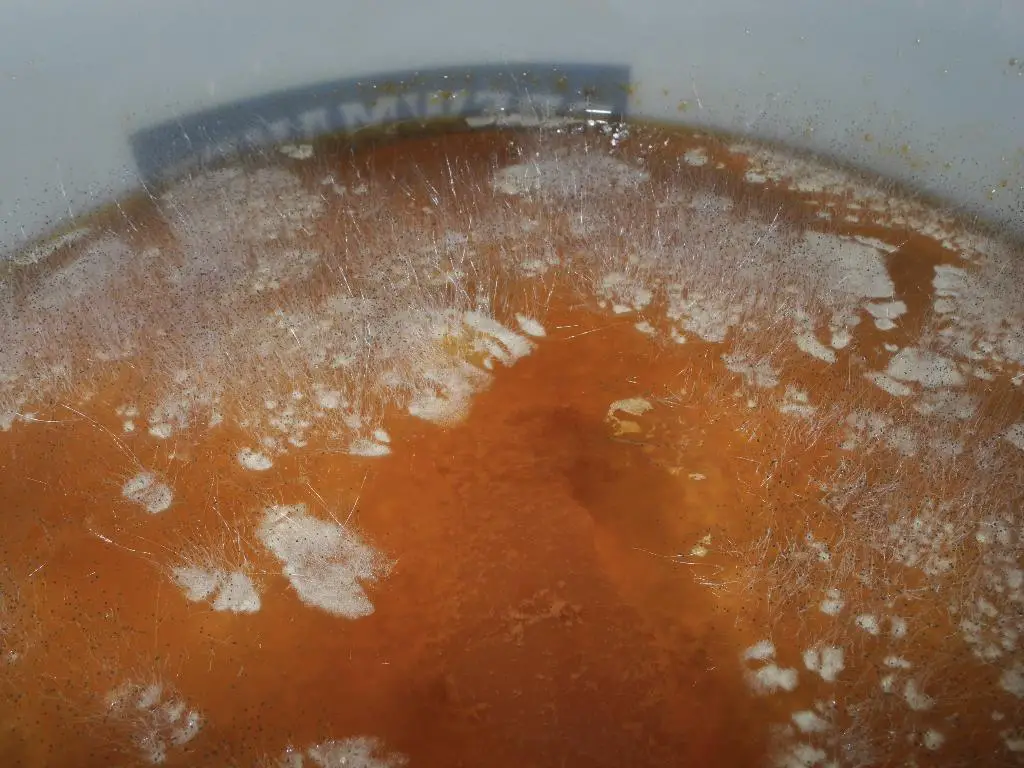Making mead is a grand and ancient tradition, a craft that involves a delicate balance of ingredients, temperatures, and time. But how can you tell if your mead has gone bad?
In this post, we will discuss the signs that your mead may not be fit for consumption, focusing on the smell, looks, taste and pH level.
To tell if mead has gone bad, you will need to pay attention to its smell, looks, taste, and pH level.
If the mead has an off-putting smell, a strange look, an unusual taste, or a pH level that is too high or too low, it may have gone bad.
The Smell of Mead
One of the first signs that your mead may have gone bad is its smell. A healthy mead should have a pleasant, sweet, and somewhat earthy aroma. An overly strong or unpleasant smell can indicate that your mead has gone bad.

Mead that has become contaminated with bacteria or wild yeasts may develop a sour, vinegary smell. This is a sign of acetic acid bacteria, which can spoil your mead.
If your mead smells like rotten eggs or sulfur, it may be due to hydrogen sulfide, a byproduct of yeast metabolism that can develop in improperly stored or overworked mead.
The Looks of Mead
The appearance of your mead can also indicate whether it’s in good health. A clear, golden color is generally a sign of a well-made mead. If your mead is cloudy, it could be a sign that it’s still fermenting, or it could indicate a problem.

If your mead has a strange color or a lot of sediment, it could be a sign of bacterial contamination. Additionally, if you see a layer of film or bubbles on the surface of your mead, it could be a sign of a bacterial or yeast infection.
The Taste of Mead
Taste is another important factor in determining the health of your mead. A good Mead should taste sweet, with a balance of honey flavors and a hint of alcohol. If your mead tastes sour, bitter, or has an off-putting aftertaste, it may have gone bad.
The taste of mead can be influenced by a variety of factors, including the quality of the honey used, the type of yeast used, and the fermentation process. If your mead tastes off, it may be due to poor quality ingredients, improper fermentation, or bacterial contamination.
pH Level of Mead
The pH level of your mead can also indicate its health. Mead should typically have a pH level between 3.7 and 4.6. A pH level outside this range could indicate a problem.
A pH level that is too high (above 4.6) could indicate bacterial contamination, as some bacteria can survive in higher pH levels.
A pH level that is too low (below 3.7) could indicate that the mead is too acidic, which can result in a sour taste and could harm the yeast, preventing proper fermentation.
Off-Flavors in Mead
Off-flavors in your mead can be a sign that it has gone bad. These can include tastes that are sour, bitter, metallic, or similar to rubber or chemicals.
These off-flavors can be caused by a variety of issues, including bacterial contamination, oxidation, improper fermentation, or the use of poor quality ingredients. If your mead has any of these off-flavors, it may be best to discard it.
What has Infected my Mead?
Here is an overview of some of the main microbes that may contaminate your honey and mead at different stages in the brewing process:
Before Fermentation:
- Acetic Acid Bacteria (AAB): Such as Acetobacter and Gluconobacter species. These bacteria can oxidize ethanol to acetic acid, resulting in vinegar flavors. They typically require oxygen to function effectively.
- Lactic Acid Bacteria (LAB): Such as Lactobacillus, Leuconostoc, and Pediococcus species. They can produce lactic acid and other compounds, which can affect the taste of the honey must.
- Wild Yeasts: Such as Candida, Pichia, and Hanseniaspora. They can compete with desirable yeasts and produce off-flavors.
- Spoilage Bacteria: Such as Enterobacteriaceae. They can produce off-flavors and aromas in must.
During Fermentation (When Turning Honey Must into Mead):
- Saccharomyces cerevisiae: This is the primary yeast used for alcoholic fermentation. While it’s desirable for fermentation, contamination with wild strains can lead to inconsistent flavors.
- Non-Saccharomyces Yeasts: Such as Metschnikowia, Brettanomyces, and Torulaspora. While some can contribute to complexity and desirable flavors in small amounts, others can produce off-flavors.
- Lactic Acid Bacteria (LAB): Can continue to be active during fermentation, potentially leading to lactic acid production and other flavor changes.
- Acetic Acid Bacteria: If exposed to oxygen during fermentation, they can produce vinegar flavors.
After Fermentation:
- Brettanomyces: Often referred to as “Brett,” it’s a wild yeast that can produce funky or barnyard flavors in mead. Some producers intentionally use Brett for complexity, but in many cases, it’s seen as a flaw.
- Lactic Acid Bacteria: Can continue to affect the mead, leading to potential spoilage or souring if not desired.
- Acetic Acid Bacteria: If the mead is exposed to oxygen post-fermentation, these bacteria can convert alcohol into acetic acid.
How to Test for Contamination?
There are a number of ways to detect microbial contamination in honey and mead. Some of the methods include:
- Microscopic Examination: A direct and quick way to observe yeast cells and bacteria.
- Microbiological Plating: This involves spreading a sample on selective media plates and incubating to encourage growth of potential contaminants. This helps in identifying and quantifying microbial presence.
- Sensory Analysis: Trained panels or tasters can sometimes detect off-flavors that indicate microbial contamination.
- Genetic Analysis: Advanced methods like PCR (polymerase chain reaction) can detect and quantify specific strains of microbes.
Mold and Bacteria in Mead
If you see any signs of mold or bacteria in your mead, this is a clear sign that it has gone bad.
This can include visible mold growth, a slimy or filmy layer on the surface of the mead, or a foul smell.
Mold and bacteria can contaminate your mead if it is not properly sanitized and stored. If you see any signs of mold or bacteria, it is best to discard the mead, as it could be harmful to consume.
Potential Bacterial Contaminants in Mead:
| Bacterium | Likelihood of Contamination | Symptoms on Mead | Prevention |
|---|---|---|---|
| Escherichia sp. | Low | Off-flavors, potential spoilage | Proper sanitation, pH control |
| Klebsiella sp. | Low to Moderate | Unpleasant odors, gas production | Avoid using damaged fruit, pH control |
| Bacillus sp. | Moderate | Off-flavors, spoilage | Thoroughly wash apples, proper sanitation |
| Staphylococcus sp. | Low | Potential spoilage, off-flavors | Avoid human contamination, proper sanitation |
| Acetobacter | High | Vinegar taste | Minimize oxygen exposure, use of airlocks |
| Alycylobacillus | Moderate | Off-flavors, spoilage | Pasteurization, pH control |
| Clostridium | Low | Gas production, potential spoilage | Avoid using damaged fruit, proper sanitation |
| Gluconobacter | High | Sourness, off-flavors | Minimize oxygen exposure |
| Lactobacillus | High | Sourness | pH control, good sanitation practices |
| Leuconostoc | Moderate | Off-flavors, potential spoilage | pH control, good sanitation |
| Saccharobacter | Low | Unpleasant odors, gas production | Proper sanitation, avoid using damaged fruit |
| Zymomonas | Moderate | Gas production, off-flavors | pH control, fermentation temperature monitoring |
| Zymobacter | Low to Moderate | Off-flavors, spoilage | Good sanitation practices, pH control |
As the list above indicates, the world of apple mead microbiology is vast and varied. Over the years, I’ve encountered a few of these bacterial guests in my brews.
Recognizing the symptoms early and having preventive measures in place has been vital in ensuring consistent quality in my mead.
Botulism Bacteria and Mead
Clostridium botulinum is a rod-shaped bacterium that produces the neurotoxin responsible for botulism, a rare but potentially fatal illness. Honey has been found to occasionally contain spores of this bacterium.

When producing mead it’s essential to understand the potential risks associated with C. botulinum and ensure that the final product is safe for consumption.
C. botulinum in Honey
Source of Contamination: Honey can become contaminated with C. botulinum spores from soil and dust during the collection process. Bees can inadvertently pick up these spores while foraging and transfer them to the honey.

Mead Production and Safety
- Fermentation Process: Mead is produced by fermenting honey with water, and sometimes with the addition of fruits, spices, or grains. During fermentation, yeast consumes the sugars in honey and produces alcohol. While the fermentation process reduces the pH and increases the alcohol content, which can deter many pathogens, it does not guarantee the elimination of C. botulinum spores.
- Pasteurization: Many commercial mead makers employ pasteurization to ensure product safety. By heating the mead to a specific temperature for a set duration, potential pathogens, including C. botulinum, are destroyed. However, homebrewers might skip this step, which can pose a risk if the product is not stored or consumed correctly.
- Alcohol and Acidity: The natural environment of mead – high in alcohol and often low in pH – is generally hostile to most bacteria. However, it’s essential to note that the spores of C. botulinum are highly resilient and might not be completely eradicated solely by the mead’s alcohol content or acidity.
- Aerobic vs. Anaerobic Conditions: C. botulinum requires an anaerobic (oxygen-free) environment to produce its toxin. Bottled mead that’s sealed can provide such conditions. Hence, ensuring the safety of the product before bottling is crucial.
- Spore Germination in Mead: While honey itself is an inhospitable environment for most bacteria due to its low water activity, high sugar concentration, and low pH, the process of turning honey into mead changes these conditions. The dilution of honey with water to make must (unfermented mead) can provide an environment where the water activity increases, potentially allowing for the germination of C. botulinum spores. However, the risk is considered low because mead, like many fermented beverages, becomes acidic and alcoholic, two conditions that hinder the growth of C. botulinum.
- Safety Concerns: The main concern would be during the early stages of fermentation, before the alcohol content rises and while the pH is still not low enough to inhibit bacterial growth. If fermentation is slowed or stalled, there might be a window of opportunity for the spores to germinate and produce toxin. However, the actual risk of this happening in real-world conditions is relatively low.
- Symptoms of Botulism: If botulinum toxin is consumed, symptoms can develop anywhere from 12 to 36 hours after ingestion, but they can also appear up to several days later. Symptoms can include blurred or double vision, difficulty swallowing, muscle weakness, and respiratory paralysis. If any of these symptoms are noted after consuming homebrewed mead, medical attention should be sought immediately.
- Prevention: To reduce the risk of C. botulinum contamination, it is crucial to follow best practices when making mead. This includes ensuring a healthy fermentation by using a strong yeast starter, ensuring that the fermentation environment is clean and sanitized, and monitoring the pH and alcohol content of the mead to ensure it remains at levels inhospitable to C. botulinum. Pasteurization is another method to kill any potential toxins, but it’s not commonly used in mead making as it might change the flavor profile of the beverage.
Recommendations for Mead Safety
- Pasteurization: If possible, pasteurizing mead can be a reliable method to ensure the destruction of any C. botulinum spores.
- Storage: Store mead in cool, dark places. While C. botulinum spores might survive, they are less likely to produce toxins under these conditions.
- Consumption: Consume homemade mead within a reasonable timeframe and always refrigerate any opened bottles.
- Educate and Inform: If producing mead for wider distribution, even among friends or at local events, ensure that consumers are aware of the potential risks and the importance of proper storage.
Conclusion
While the risk of botulism from consuming mead is low, especially when proper production and storage techniques are employed, it is not negligible.
It’s crucial for both commercial and home producers to understand the risks associated with C. botulinum in honey and take appropriate measures to ensure the safety of their products.
The Age of Mead
While mead can age well, it’s also true that it can go bad over time. If your mead is more than a few years old and hasn’t been stored properly, it may have gone bad.
Mead should be stored in a cool, dark place, with a stable temperature. If it has been exposed to heat, light, or fluctuating temperatures, it may have gone bad. If your mead is old and has been improperly stored, it’s best to err on the side of caution and discard it.
Trust Your Senses
In the end, the best way to tell if your mead has gone bad is to trust your senses. If your mead smells, looks, tastes, or feels off, it’s probably best to discard it.
Remember, it’s always better to be safe than sorry. If you’re unsure about the quality of your mead, it’s best not to consume it.
It’s crucial to maintain strict hygiene standards throughout the brewing process. Regular cleaning and sanitizing of equipment, using quality ingredients, and controlling the fermentation environment can go a long way in preventing contamination. Consider using sulfites or other preservatives, when appropriate, to inhibit microbial growth.
Remember, brewing is as much an art as it is a science. Keeping a keen eye on potential contaminants will ensure that your mead is consistently delicious and free from unwanted invaders!
Conclusion
In conclusion, telling if your mead has gone bad involves checking its smell, appearance, taste, and pH level. Here are some key points to remember:
1. Good mead should have a pleasant, sweet smell.
2. A clear, golden color is a sign of well-made mead.
3. Mead should taste sweet, with a balance of honey flavors and alcohol.
4. The ideal pH for mead is between 3.7 and 4.6.
5. Off-flavors can indicate that mead has gone bad.
6. Visible mold or bacteria is a clear sign of spoilage.
7. Mead can go bad over time, especially if improperly stored.
8. Trust your senses. If something seems off, it probably is.
In my personal experience, the craft of brewing mead is a rewarding one, but it does require vigilance and care. Always pay attention to the signs that your mead might have gone bad, and never risk consuming mead that you suspect might be spoiled. Your health, and the quality of your craft, is worth more than a bottle of mead. Happy brewing!
FAQs
How do I know if my mead has botulism?
Botulism is a serious illness caused by a toxin produced by the bacterium Clostridium botulinum, that is not necessarily killed by alcohol. While it is rare, it is important to be cautious. Signs of botulism include difficulty swallowing, speaking, or breathing, muscle weakness, blurred vision, and paralysis. If you suspect your mead may have been contaminated, it is crucial to seek medical attention immediately.
Can bad mead make you sick?
Yes, bad mead can make you sick. If mead is made improperly or becomes contaminated with harmful bacteria or spoilage organisms, it can cause foodborne illnesses such as food poisoning. These illnesses can lead to symptoms like nausea, vomiting, diarrhea, and stomach cramps. It’s important to ensure that mead is made and stored properly to avoid any potential health risks.
How common is botulism in mead?
Botulism is a rare occurrence in mead. The risk of botulism in properly produced and stored mead is very low.
How do I know if my mead is safe?
To ensure the safety of your mead, there are a few key factors to consider. Firstly, check for any signs of spoilage or contamination, such as unusual odors, mold growth, or off flavors. If the mead looks and smells normal, it’s a good start. Additionally, verify that the fermentation process was carried out properly, with the correct yeast and in a controlled environment. The alcohol content should be sufficient to inhibit the growth of harmful bacteria or pathogens. Lastly, taste a small amount to check for any unusual flavors or excessive acidity, as these could indicate an issue. If everything appears and tastes fine, your mead is likely safe to consume.
What does spoiled mead taste like?
Spoiled mead can taste unpleasant and off-putting. It may have a sour or vinegary taste, indicating the presence of acetic acid. The mead might also have a strong, unpleasant odor, similar to rotten fruit or spoiled wine. Overall, spoiled mead is generally unenjoyable and not suitable for consumption.
How do you know if your mead is contaminated?
You can tell if your mead is contaminated by observing certain signs. Look out for unusual colors, such as green or black, floating particles, or a foul odor. If the mead tastes off, sour, or vinegary instead of sweet and pleasant, it could indicate contamination. Additionally, if you notice excessive carbonation or the presence of mold, it is likely contaminated.




